CHARGER 3 RC2 FORK DAMPER
When you are charging downhill, plowing through rock gardens, skipping over braking bumps in berms, and deciphering lines on the fly—around or over—there’s one part of your fork that keeps your hands from flying off the handlebars—the damper. Responsible for adding compression damping and more control to the fork, in both repetitive small bumps and big hits, your damper controls how your bike responds to terrain as well as your input and feedback.
Bringing a fresh set of eyes and years of experience designing rear shocks, RockShox Senior Design Engineer Tim Lynch was given a blank sheet of paper to design a brand-new damper for our 2023 Fork Lineup. Most familiar with an Internal Floating Piston (IFP) damper design, Lynch decided to take what he knew from the rear shock world and merge it with the internals of forks to revolutionize damper tunability.
The end result? Charger 3—a damper designed to tune the exact combination of settings for your ride style and the trail you’re on, without sacrifice or hesitation.

All of this was made possible because of a new design featuring a spring-backed, IFP cartridge damper—a sealed and fully self-contained system—offering riders a very consistent feel through the stroke. Consistency is one thing, but adjustability allows riders to find their sweet spot. You know the one, where you feel connected to your bike and begin entering flow state. Our primary goal with Charger 3 was to give riders more adjustability, so with a team of engineers, Lynch set out to create truly independent High Speed Compression (HSC) and Low Speed Compression (LSC) adjustments and eliminate what we call “cross-talk.” Before we dive into that, let's talk a bit about damping theory.
Damping Theory

Above: the Charger 3 headvalve cutaway, showing the High Speed Compression (HSC) and Low Speed Compression (LSC) adjusters.
In suspension, dampers are paired with springs to control the speed at which the spring absorbs and releases energy, using a system of valves that allow the oil to flow freely (the Open position), or restricts the flow of oil (the Closed position). When we say to open up your suspension (or reduce damping), that means there is less restriction of oil, and the suspension will compress more freely. When we say to close your suspension (or add damping), that means the oil flow is restricted and will take more force or time to compress. This theory applies to both High Speed Compression (HSC)—which controls how the fork feels in high-speed, quick impacts, and Low Speed Compression (LSC)—which controls how the fork feels in gradual compression events like corners, weight shifts, and transitions. It also applies to Rebound—but that’s a conversation for another time.
In traditional dampers, HSC and LSC are a part of the same flow network—adjusting one also adjusts the other. For example, you adjust your HSC because the fork feels rough or jarring on this trail (but felt great on the last one), and that also adjusts the LSC, which then can make the fork feel unsupported or floppy. We call this "cross-talk"—when one adjustment "talks" over the other.
Lynch explains, "Essentially, when you adjust your High Speed Compression, you are adjusting preload on a spring that's pushing on a shim stack, offering resistance in the oil path. When you open the High Speed Compression adjuster, the shim stack is free to lift, allowing oil to flow more easily. Unfortunately, that shim stack is also what's creating your back pressure to make that Low Speed Compression adjuster valve work. So, you end up with this unintended and unwanted link. With no High Speed Compression tension on the spring, there's no pressure on the shim stack, making your Low Speed valve ineffective."
To eliminate “cross-talk,” Lynch decoupled the HSC and LSC by designing the valves to be sequential—meaning the oil must flow first through the HSC and then the LSC, making them independent of one another. Now you can adjust your LSC without affecting your HSC and vice versa. With Charger 3, now you adjust your HSC because the fork feels rough or jarring on this trail (but felt great on the last one), and that makes the fork feel smoother and more controlled but still maintains the ride height and low speed support since the LSC was left untouched.
So, How Does Charger 3 Work?
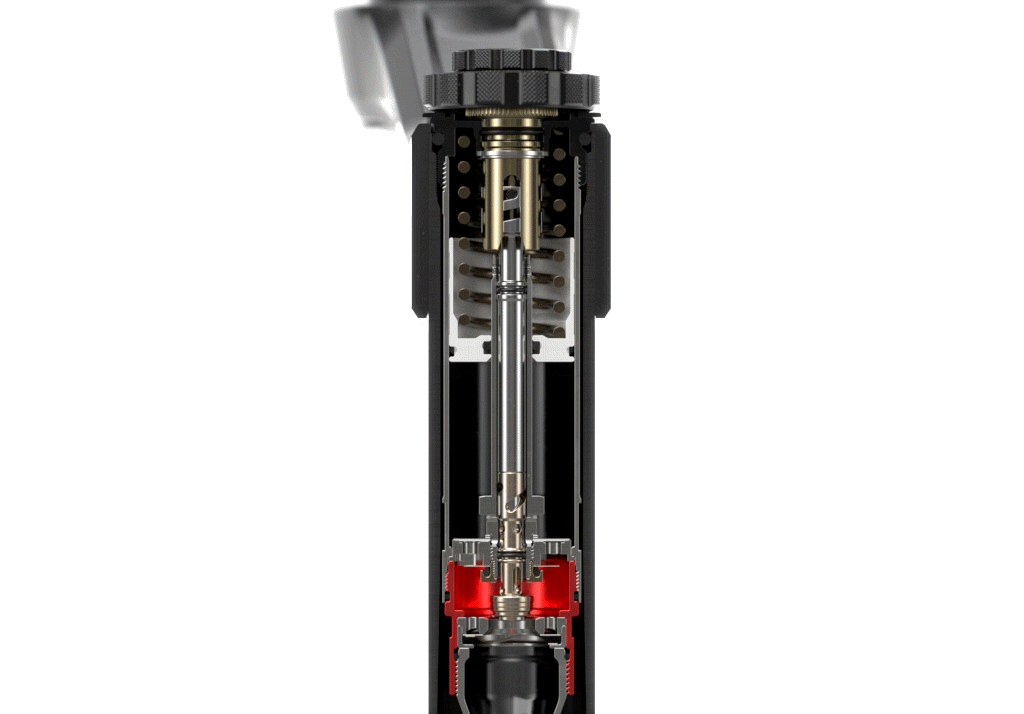
Above: Rotating through the High Speed Compression (gold pyramid) and Low Speed Compression (silver needle) adjusters.
Here's how it works: as the oil in the damper cartridge is displaced upwards during compression, the oil first encounters the High Speed circuit before flowing into the Low Speed circuit. If both the HSC and LSC are in the Open position, the oil will flow freely through both circuits, allowing for full, easy compression. Now, let's say you close the HSC but leave the LSC open. The oil flow is restricted through the HSC, but because LSC by nature is slower and requires less oil flow (remember, LSC is all about those slower, gradual impacts), there is still plenty of oil moving through the HSC circuit to allow the LSC circuit to remain in the full-flow, Open position. If we flip it to open the HSC circuit and close the LSC circuit, there's full flow of the oil through the HSC circuit (which comes first), and then the oil moves through the LSC circuit, causing more pressure and oil build-up, equaling more damping in the LSC circuit. It's important to note we're using Open and Close to demonstrate the extremes of the settings, but the range of adjustment is a spectrum and there are many clicks of adjustment between Open and Close for both HSC and LSC.
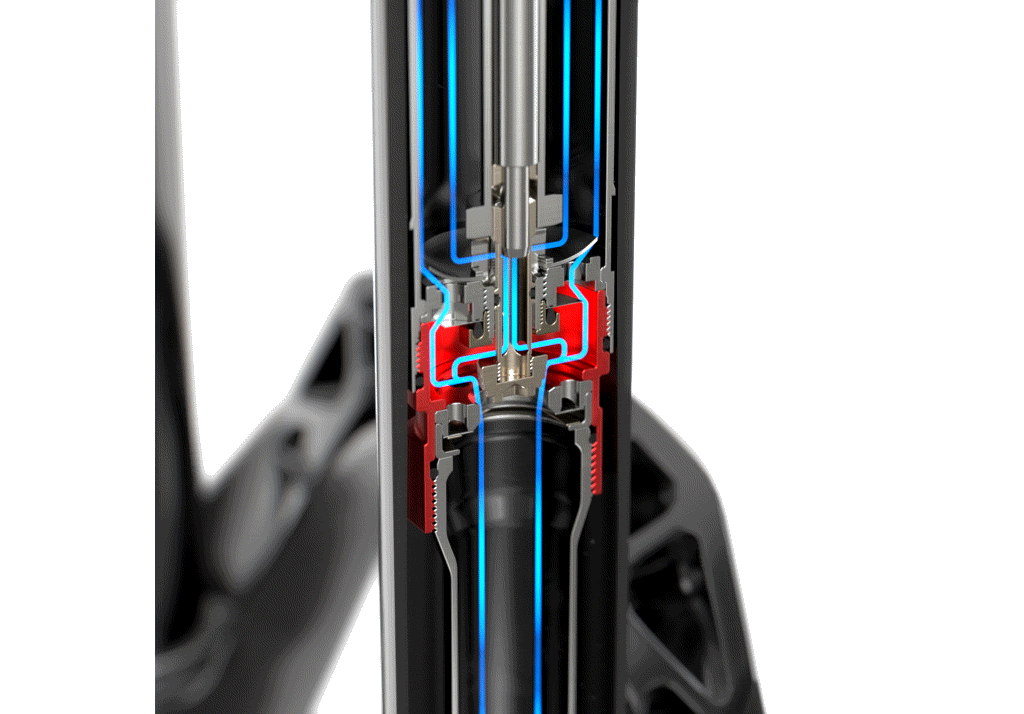
Above: Demonstrating oil flow through the system. First, the Low Speed Compression needle rotates down to close off the Low Speed port and push the oil through the hard path, then the HSC pyramid rotates down to close off the HSC port, causing pressure to build below the HSC port. Finally, both rotate back up to full Open with even flow.
Let's go a level deeper and talk about what happens when we close off adjusters. The HSC circuit uses an adjustable orifice—the size of the orifice directly affects how much oil can get through at a given pressure. When it's in the Open position, oil flows freely through the HSC port and into the LSC circuit. When the HSC is Closed, the space for the oil to flow is drastically cut down, creating more damping. Think of one of those large sliding doors like what you might see at a supermarket, then imagine a large crowd exiting that door in a calm and orderly manner. It's a smooth flow. That's the HSC circuit in the Open position. Now imagine that those doors have been halfway closed, and someone pulls a fire alarm—suddenly, the crowd is pushing to get out the door, causing movement to slow down, or even stop, because too many people are trying to squeeze through. This increases pressure, like the HSC circuit in the Closed position, which leads to more damping.
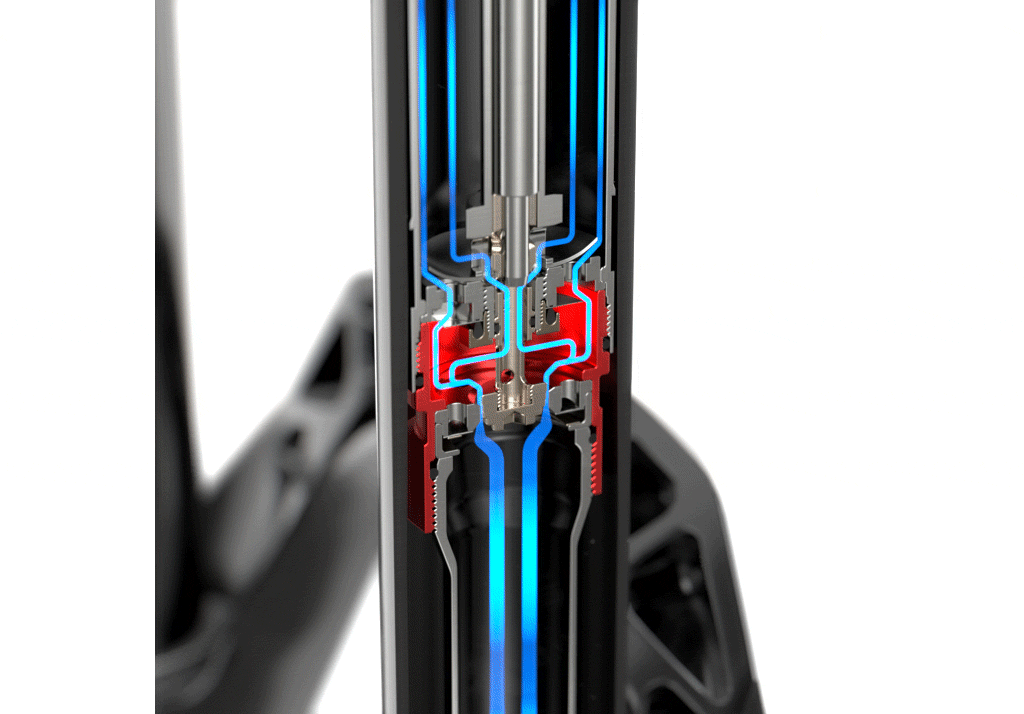
Above: Demonstrating oil flow with the HSC circuit closed, the oil still flows steadily through the LSC circuit, including both easy and hard paths. Notice the oil flow has pressurized below the HSC port, creating more damping.
The LSC circuit functions a bit differently. When the LSC adjuster is rotated toward either Open or Close, it forces the oil to flow through different paths—an easier path, and a harder path. The easy path allows the oil to flow with the least resistance (when the adjuster is set closer to the Open position), while the hard path forces the oil to flow through harrowing obstacles that require grit and determination. Just kidding, there's just added resistance in the hard path. Again, because the HSC and LSC are sequential, the flow through the HSC does not affect the LSC, so even when the oil flow has slowed down due to the HSC adjuster being closed, the LSC is still able to function independently. The LSC easy path routes the oil up through the center of the damper and out of the ports within the LSC needle. However, when the LSC adjuster is Closed, it rotates the LSC needle down, blocking the LSC ports and forces the oil to go through the harder outside path where it must push its way past a shim stack, slowing down the oil flow and creating pressure.
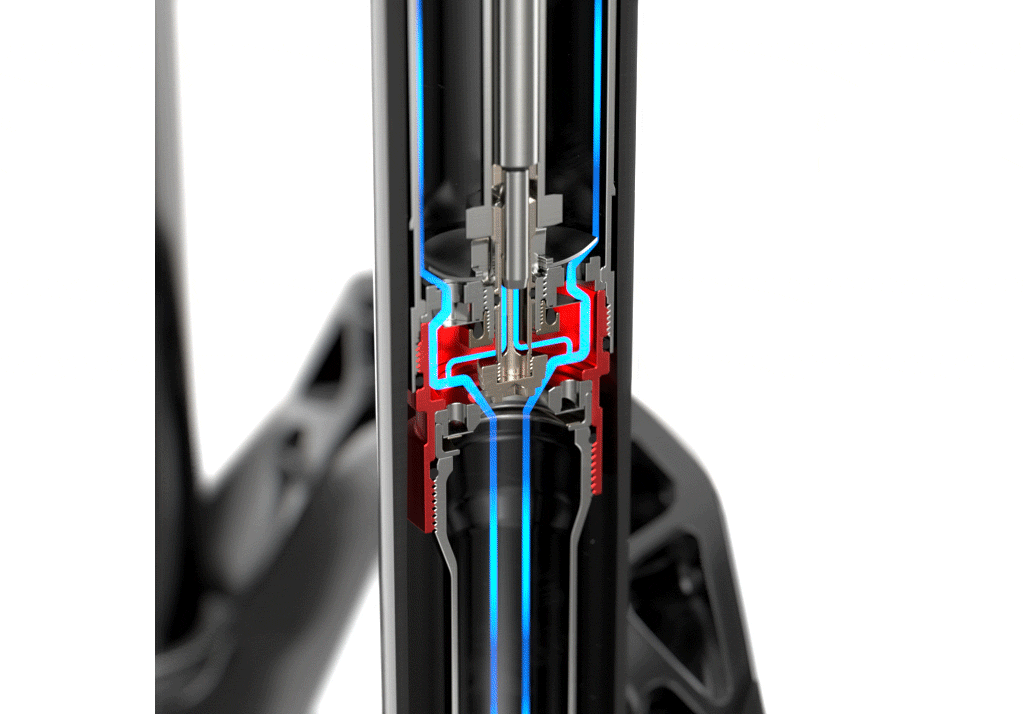
Above: Demonstrating oil flow with the LSC circuit closed, forcing the oil to flow through the LSC hard path. Notice the oil flow through the hard path (the outside path within the red sealhead) is pressurized, creating more damping.
Proof
Now that we've explained how it works, let's take a look at a compression damping study measuring the effectiveness of HSC and LSC adjusters in other dampers versus Charger 3. Figure 1 below is a sample damping curve with Force (amount of damping from low to high Force) on the Y-axis and Velocity (the speed at which the damper moves from low to high speed) along the X-axis. As you increase Velocity, you also increase Force and vice versa.
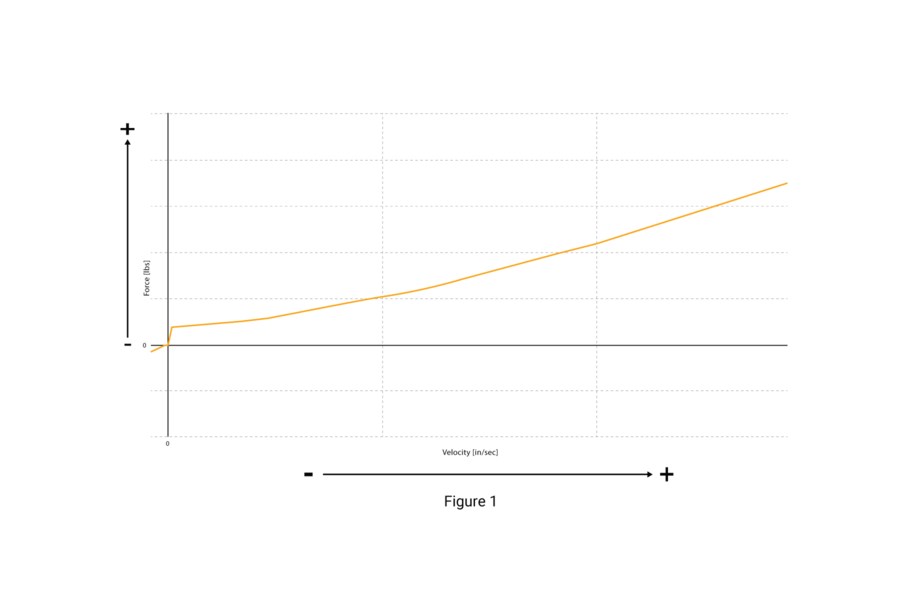
To show exactly how effective HSC and LSC adjusters are, we compared the Other Damper’s range of compression adjustability (Figure 2) to Charger 3 (Figure 3). Both Figure 2 and Figure 3 show similar HSC and LSC damping curves when both are Open (green) and Closed (red). Where they differ is those dotted lines in the middle: blue representing the LSC closed and HSC open, and yellow representing LSC open and HSC closed. We’ll take a dive into the relationships between the lines and what that means for adjustability.
With Other Dampers (Figure 2), compare the solid green Open/Open line with the dashed yellow line representing LSC open and HSC closed. With the LSC open, it follows the solid green line closely while in the low velocity range. Then as Velocity increases, Force also goes up. This is what you’d expect to see with HSC closed and LSC open. It gets confusing when comparing the blue dashed line (showing LSC closed and HSC open) and the solid red Closed/Closed line—both these lines have the same LSC position: Closed. The force of the LSC should go up when the adjuster is closed to match the solid red line, but instead, the force goes way down, almost to the solid green Open/Open line. This relationship demonstrates the link between HSC and LSC that we covered earlier in this article; adjusting HSC removes the tension from the shim stack and renders the LSC valve mostly ineffective. Overall, this chart shows that the LSC is highly dependent on the HSC setting, and therefore the adjustments are not independent.
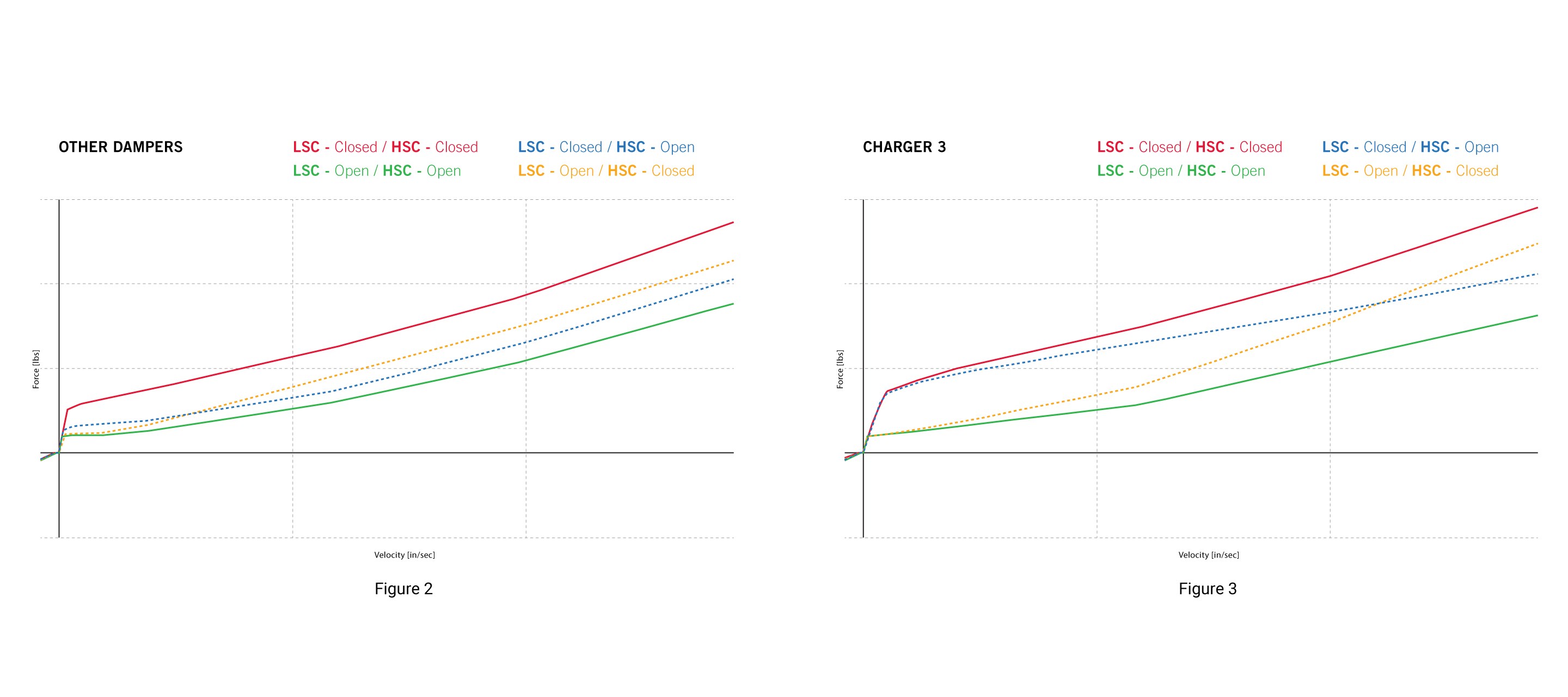
With Charger 3 (Figure 3), the blue dashed line representing the LSC Closed/HSC Open is almost identical to the solid red Closed/Closed line at lower velocities, demonstrating that LSC is effective when closed. As Velocity increases, the damper curve trends toward the green solid line, demonstrating that LSC damping force is not affected by the position of the HSC adjuster—you can adjust HSC through its entire range without affecting LSC. Next, let's focus on the yellow dashed line and compare how it relates to the solid green Open/Open line—they are just about identical at lower velocities, but then the yellow dashed line trends upwards toward the solid red line at higher velocities. This demonstrates that you can adjust the HSC from Open to Closed without affecting LSC. Overall, this chart demonstrates how each adjuster works independently of one another, meaning you can tune your HSC and LSC separately—each click is meaningful and precise.

Rider Benefit
So, this technology is super cool, but what does it do for you as a rider? With the independent HSC and LSC tunability, you can add exactly the amount of damping you want. It also means that adding damping just adds damping—not harshness or feedback. Whether you prefer less damping for a playful and lively feel without sacrificing control on big hits, or more damping for control in G-outs and berms without sacrificing the easy compression needed when encountering a water bar, you can find your perfect setup. While you can just set it and forget it, we think you should tune your fork like you'd tune your stereo, playing with treble, bass, and volume to find the perfect fit for each trail—there are no wrong combinations.
You can close both and have a great time. You can open both and have a great time. Have one closed, one open, or put them both in the middle, it's all going to feel great. And, they actually do what you think they should do. You really can't put this thing in a bad spot.
–Tim Lynch
The new Charger 3 RC2 damper can be found in the 2023 RockShox Ultimate and Select+ models of Pike, Lyrik, and ZEB. Want to learn more about setting up your specific Charger 3-equipped fork? Check out the Charger 3 Set Up article to get dialed in. Looking for more information on setting up your suspension? Check out the RockShox Trailhead App, the perfect starting point to get your suspension dialed in for the perfect ride. You can find tuning recommendations, upgrade information, and service support customized for your suspension. The RockShox Suspension Setup and Tuning Guide is another great resource to understanding each adjustment on your suspension forks and rear shocks. Questions about fitment and compatibility? Check out our 2023 Fork Collection FAQ page.

Renderings by Ray Bach. Photos by Mason Mashon and James Stokoe. Words by Sarah Walter.